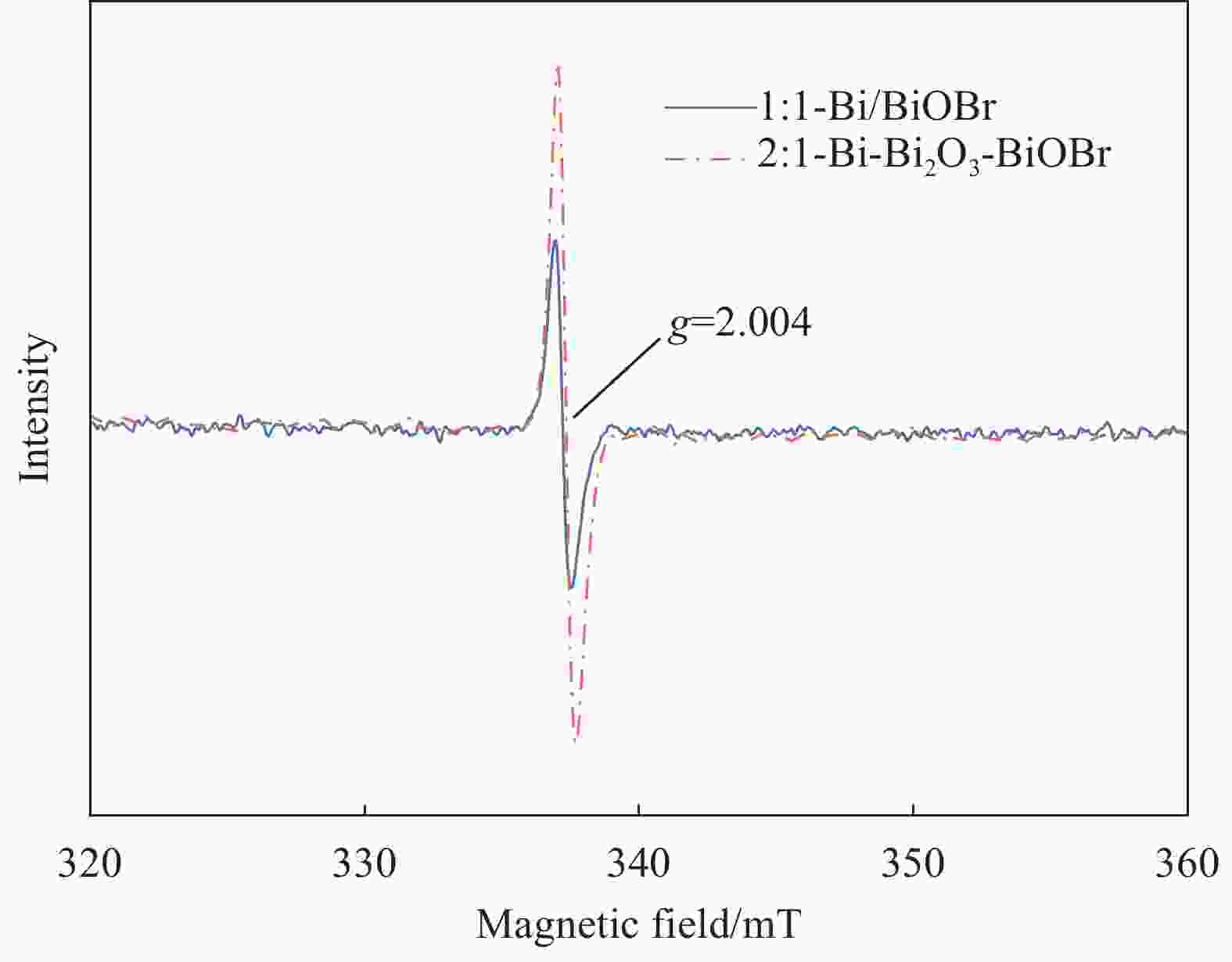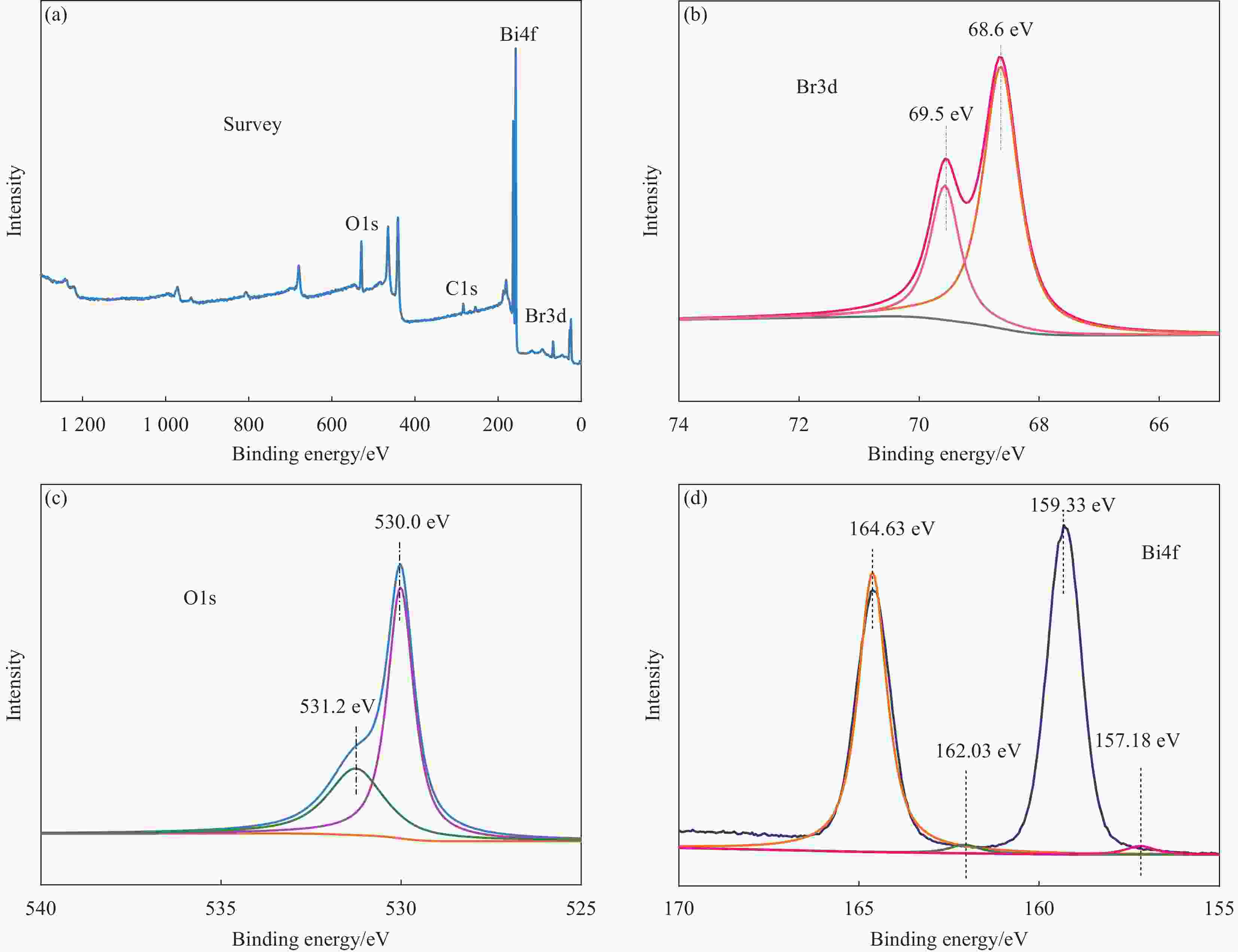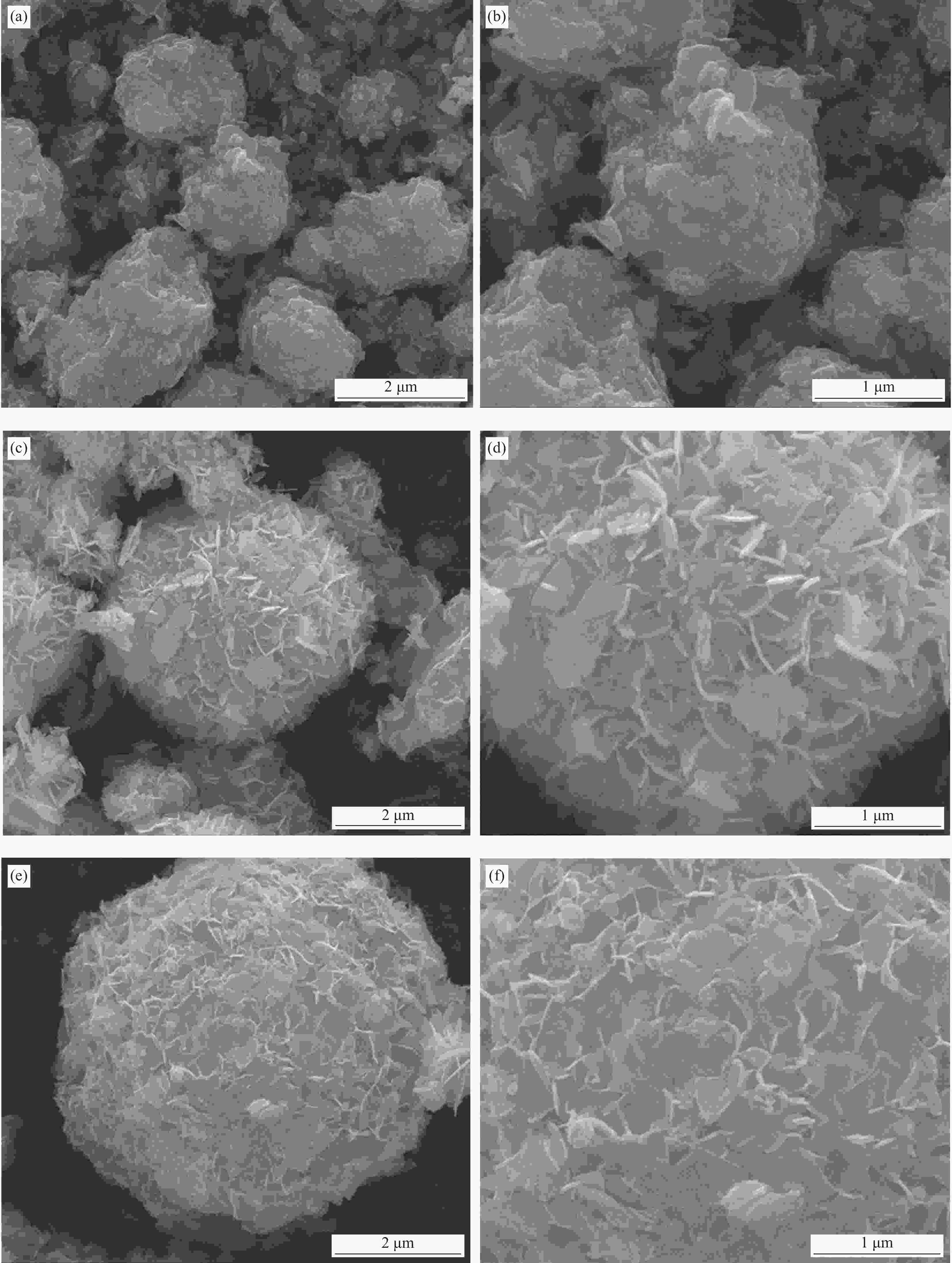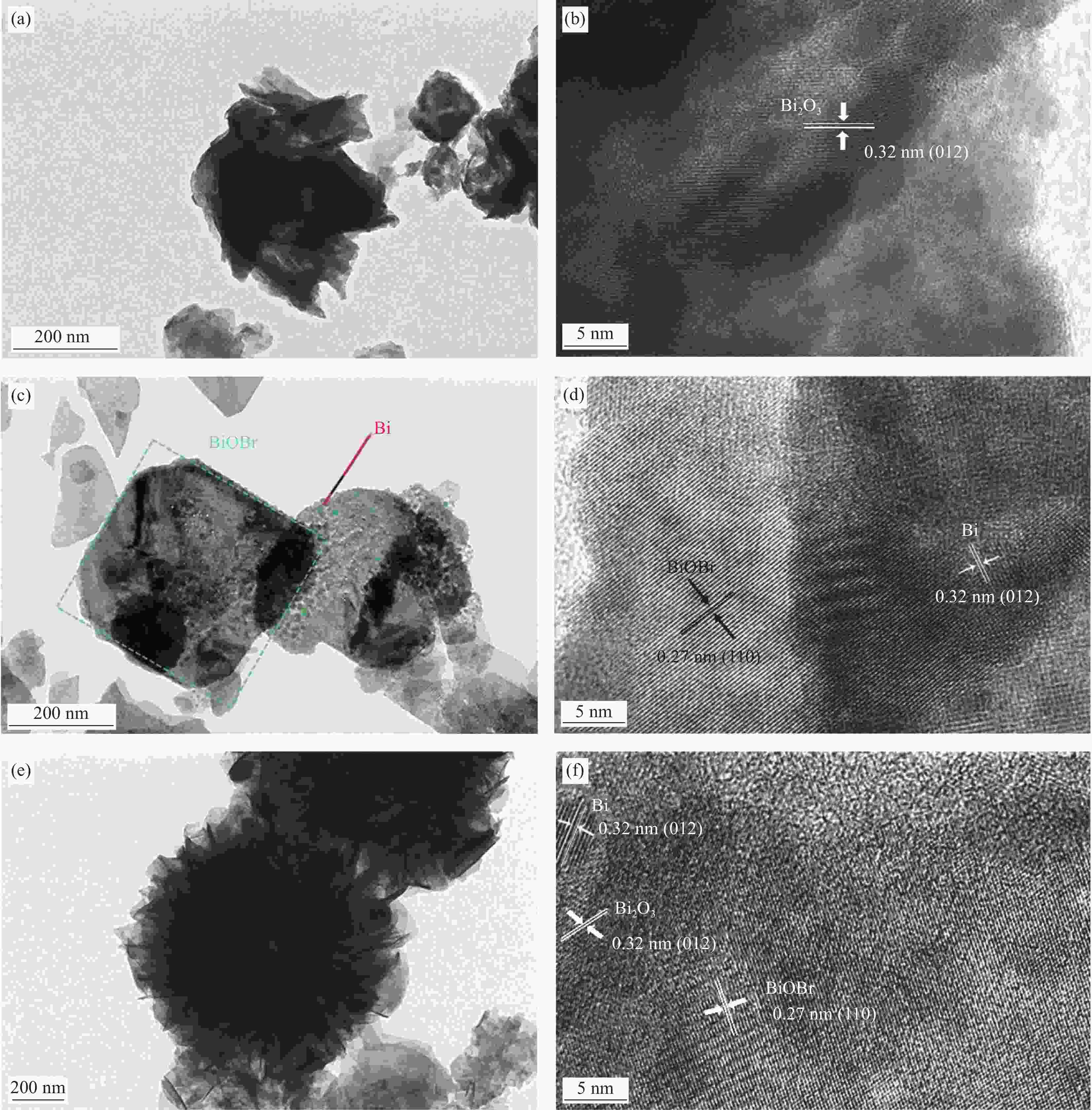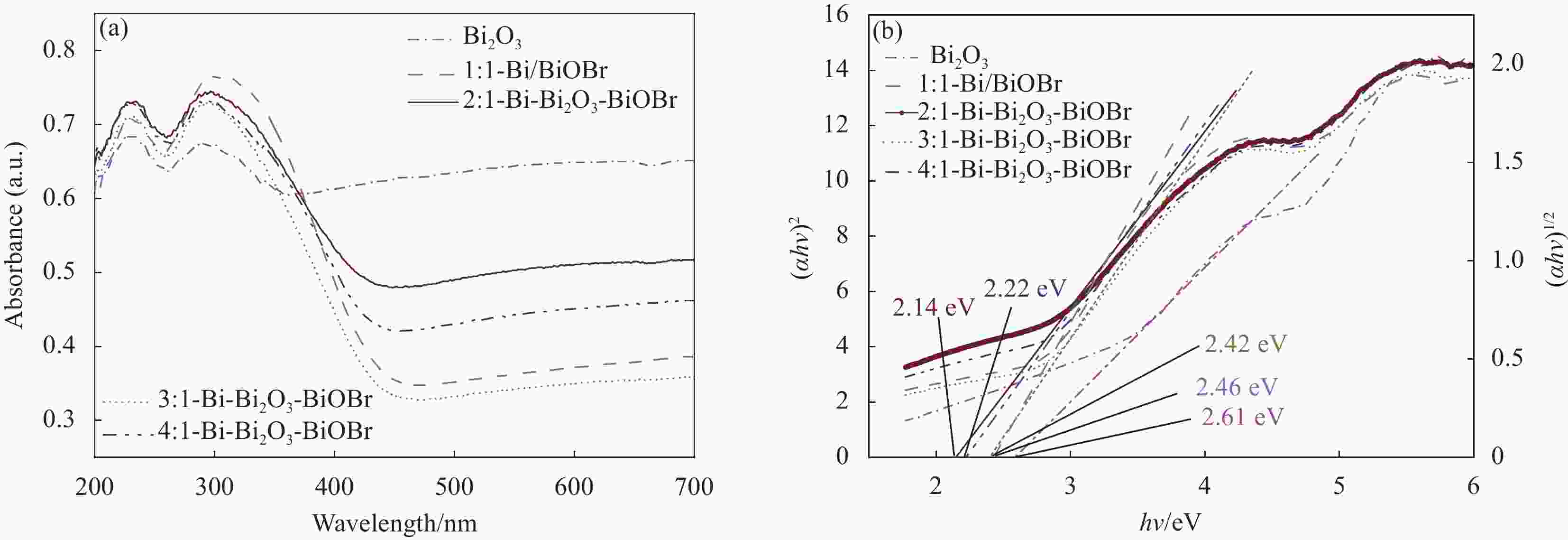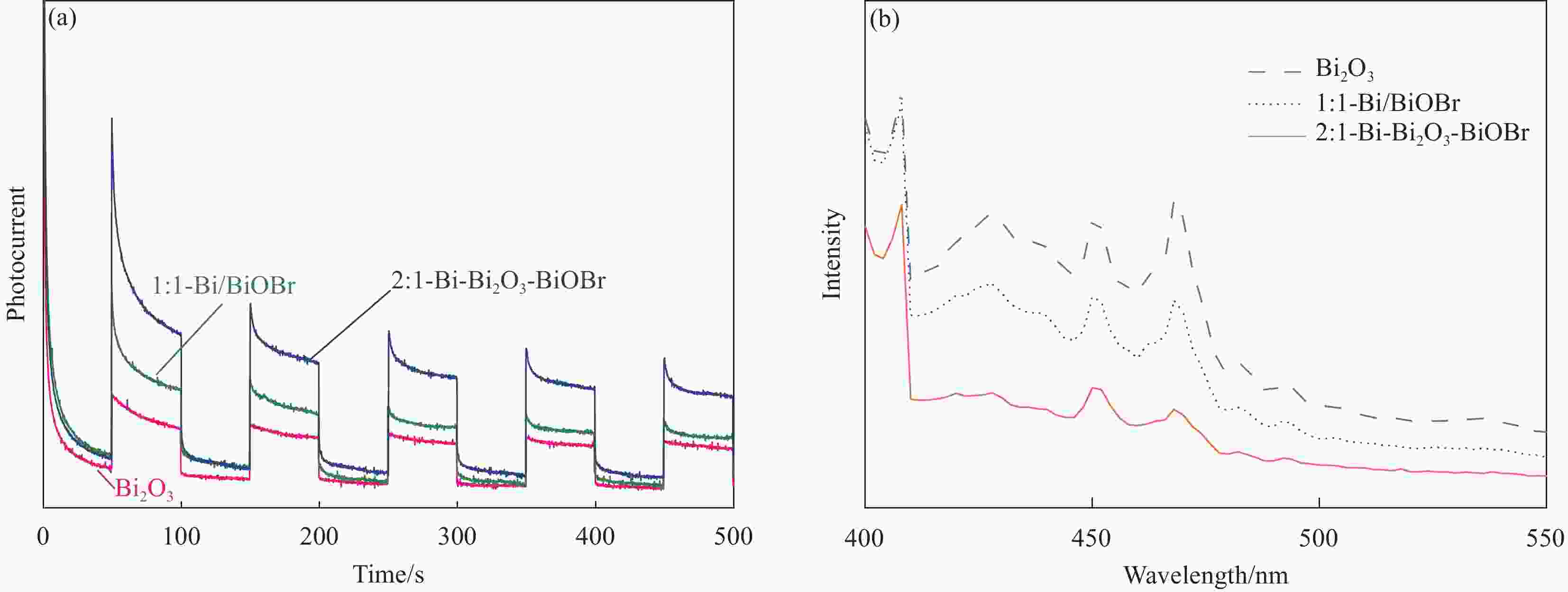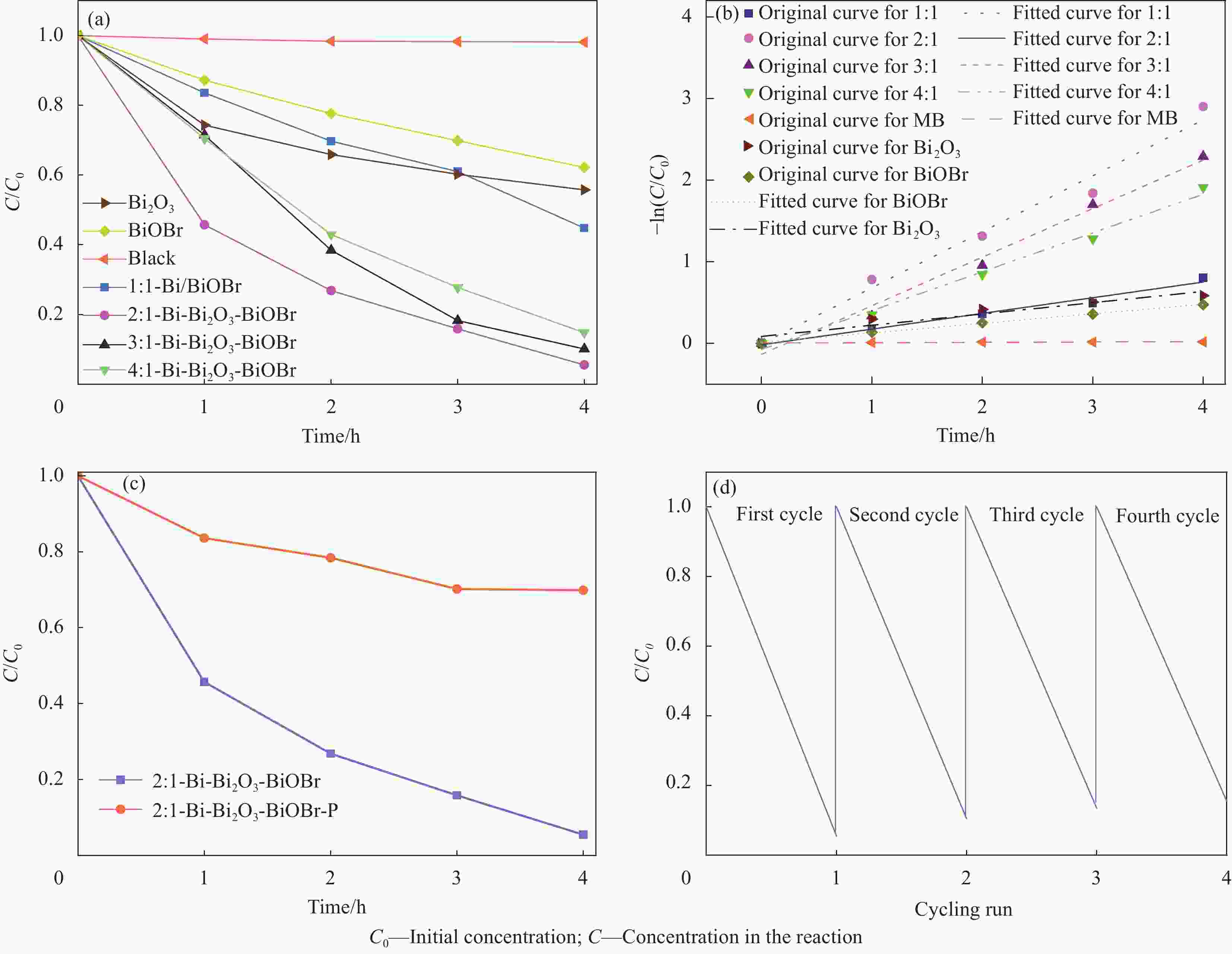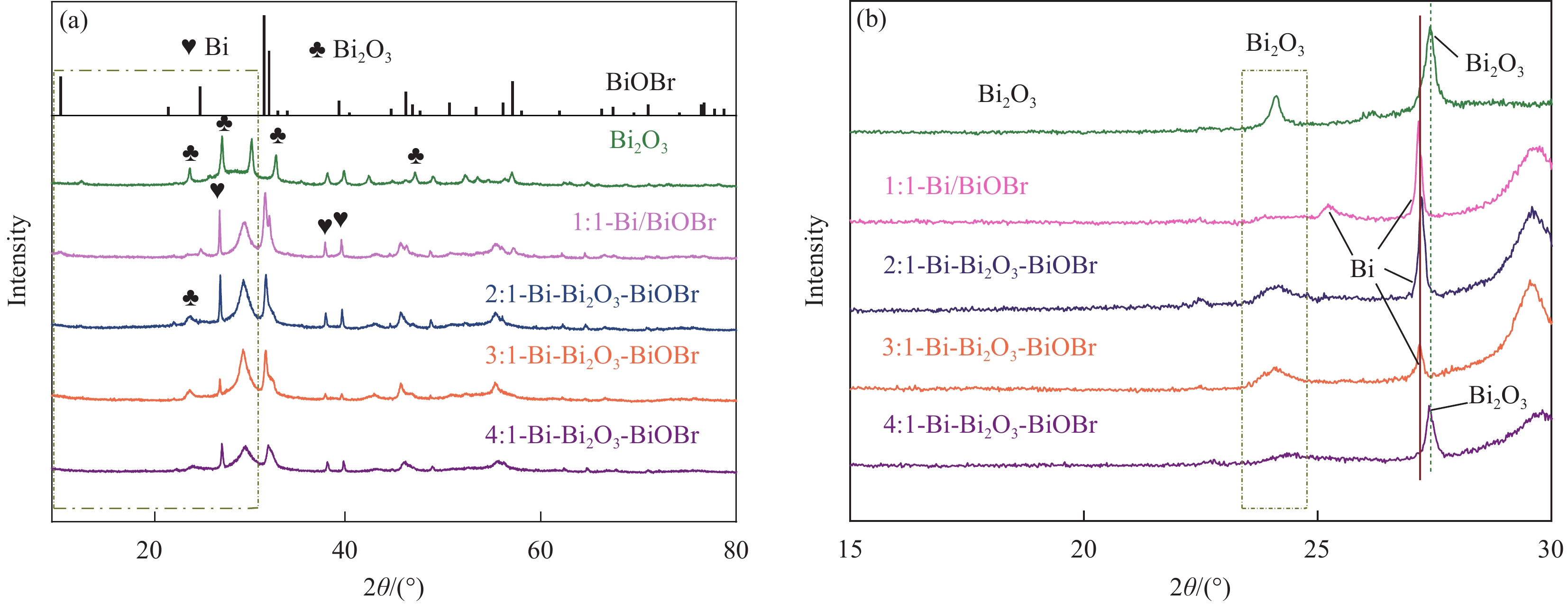One-step solvothermal preparation of Bi-Bi2O3-BiOBr ternary complex and its visible light-driven catalytic degradation of methylene blue
-
摘要: 构建表面等离子体共振(SPR)、氧空位、异质结是提升半导体光催化剂催化活性的有效方式之一。本文通过改变Bi(NO3)3与KBr的摩尔比,采用一步溶剂热法合成了具有SPR效应和氧空位的Bi-Bi2O3-BiOBr三元异质结复合材料。利用XRD、电子顺磁共振(EPR)、 XPS、SEM、TEM、UV-vis等手段对所得产物的晶相、元素组成和微观形貌进行表征分析,考察Bi(NO3)3与KBr的摩尔比对三元复合物可见光驱动光催化降解亚甲基蓝(MB)活性的影响。结果表明:Bi-Bi2O3-BiOBr的催化活性依赖于Bi(NO3)3与KBr的摩尔比,但高于纯Bi2O3和BiOBr。Bi(NO3)3与KBr摩尔比为2∶1制备的2∶1-Bi-Bi2O3-BiOBr对MB展现了最佳光催化活性:在240 min的可见光照射下, 2∶1-Bi-Bi2O3-BiOBr上对MB的去除率为95.07%,降解动力学符合准一级动力学,降解速率常数为2.90 h−1,分别是纯Bi2O3和BiOBr的5倍与6倍,经4次循环实验后,2∶1-Bi-Bi2O3-BiOBr复合材料对MB的除去效率没有显著的降低。该物质优异的可见光光催化活性催化机制可归结为SPR效应、半导体异质结结构和氧空位的3种协同作用。本文合成特殊结构光催化剂的方法可推广到其他催化材料。Abstract: The construction of surface plasmon resonance (SPR), oxygen vacancies, and heterojunctions is one of the effective ways to enhance the catalytic activity of semiconductor photocatalysts. In this paper, Bi-Bi2O3-BiOBr ternary heterojunction composites with SPR effect and oxygen vacancies were synthesized by a one-step solvothermal method by changing the molar ratio of Bi(NO3)3 to KBr. Used XRD, electron paramagnetic resonance (EPR), XPS, SEM, TEM, UV-vis and other means to characterize and analyze the crystal phase, elemental composition and microscopic morphology of the obtained product, and investigate the effect of the molar ratio of Bi(NO3)3 to KBr on the visible light-driven photocatalytic degradation of methylene blue (MB) activity of the ternary complex. The results show that the catalytic activity of Bi-Bi2O3-BiOBr depends on the molar ratio of Bi(NO3)3 to KBr, but is higher than that of pure Bi2O3 and BiOBr. The 2∶1-Bi-Bi2O3-BiOBr prepared with a molar ratio of Bi(NO3)3 to KBr of 2∶1 exhibited the best photocatalytic activity towards MB. 2∶1-Bi-Bi2O3-BiOBr was irradiated with visible light for 240 min. The removal rate of MB on Bi-Bi2O3-BiOBr is 95.07%, and the degradation kinetics conform to pseudo-first-order kinetics. The degradation rate constant is 2.90 h−1, which is 5 and 6 times that of pure Bi2O3 and BiOBr, respectively. After 4 cycles of experiments, 2∶1-Bi-Bi2O3-BiOBr composite does't significantly reduce the removal efficiency of MB. The excellent visible-light photocatalytic activity of this material can be attributed to the three synergistic effects of SPR effect, semiconductor heterojunction structure and oxygen vacancies. The method for synthesizing photocatalysts with special structures in this paper can be extended to other catalytic materials.
-
Key words:
- solvothermal method /
- BiOBr /
- photocatalysis /
- oxygen vacancies /
- heterojunctions /
- semiconductor photocatalysts
-
图 8 样品光降解亚甲基蓝(MB)曲线图(a)和反应速率常数图(b);(c) 2∶1-Bi-Bi2O3-BiOBr和2∶1-Bi-Bi2O3-BiOBr-P(物理法制备)在可见光条件下降解MB;(d) 2∶1-Bi-Bi2O3-BiOBr在可见光条件下的循环实验
Figure 8. Photocatalytic degradation curves of methylene blue (MB) (a) and reaction rate constants k (b) for samples; (c) Photocatalytic degradation of aqueous MB using 2∶1-Bi-Bi2O3-BiOBr and 2∶1-Bi-Bi2O3-BiOBr-P (physical preparation) under visible light irradiation; (d) Cycling runs of 2∶1-Bi-Bi2O3-BiOBr composite under visible light irradiation
图 9 (a) 不同捕获剂对2∶1-Bi-Bi2O3-BiOBr光催化剂光降解MB性能的影响; (b) 缺陷型Bi-Bi2O3-BiOBr纳米复合材料在可见光照射下去除MB光催化机制
Figure 9. (a) Effect of different scavengers on 2∶1-Bi-Bi2O3-BiOBr photocatalytic degradation MB performance; (b) Mechanism for aqueous MB removal catalyzed by defective Bi-Bi2O3-BiOBr nanocomposites under visible light irradiation
SPR—Surface plasmon resonance; VB—Valence band; CB—Conduction band; OVS—Oxygen vacancy site; BQ—Benzoquinone; IPA—Isopropanol; AO—Ammonium oxalate; NHE—Normal hydrogen electrode
表 1 实验对照组
Table 1. Experimental control group
Sample KBr/mmol Bi(NO3)3/mmol 1∶1-Bi/BiOBr 1 1 2∶1-Bi-Bi2O3-BiOBr 1 2 3∶1-Bi-Bi2O3-BiOBr 1 3 4∶1-Bi-Bi2O3-BiOBr 1 4 Bi2O3 — 1 -
[1] VERMA A, PRAKASH N T, TOOR A P. Photocatalytic degradation of herbicide isoproturon in TiO2 aqueous suspensions: Study of reaction intermediates and degradation pathways[J]. Environmental Progress & Sustainable Energy,2014,33(2):402-409. [2] ZHANG K, LIU C, HUANG F, et al. Study of the electronic structure and photocatalytic activity of the BiOCl photocatalyst[J]. Applied Catalysis B: Environmental,2006,68(3-4):125-129. doi: 10.1016/j.apcatb.2006.08.002 [3] CAO J, XU B, LUO B, et al. Novel BiOI/BiOBr heterojunction photocatalysts with enhanced visible light photocatalytic properties[J]. Catalysis Communications,2011,13(1):63-68. doi: 10.1016/j.catcom.2011.06.019 [4] JIANG Z, YANG F, YANG G, et al. The hydrothermal synthesis of BiOBr flakes for visible-light-responsive photocatalytic degradation of methyl orange[J]. Journal of Photochemistry and Photobiology A: Chemistry,2010,212(1):8-13. doi: 10.1016/j.jphotochem.2010.03.004 [5] 李晓晖, 彭冬, 袁小亚, 等. 卤氧化铋光催化剂改性的研究进展及应用[J]. 装备环境工程, 2020, 17(8):85-90.LI Xiaohui, PENG Dong, YUAN Xiaoya, et al. Research progress and application on bismuth oxyhalide photocatalyst modification[J]. Equipment Environmental Engineering,2020,17(8):85-90(in Chinese). [6] CHEN J, QIN S, SONG G, et al. Shape-controlled solvothermal synthesis of Bi2S3 for photocatalytic reduction of CO2 to methyl formate in methanol[J]. Dalton Transactions,2013,42(42):15133-15138. doi: 10.1039/c3dt51887f [7] WEI X X, CUI B, WANG X, et al. Tuning the physico-chemical properties of BiOBr via solvent adjustment: Towards an efficient photocatalyst for water treatment[J]. CrystEngComm,2019,21(11):1750-1757. doi: 10.1039/C8CE02072H [8] FU J, TIAN Y, CHANG B, et al. BiOBr-carbon nitride heterojunctions: Synthesis, enhanced activity and photocatalytic mechanism[J]. Journal of Materials Chemistry,2012,22(39):21159-21166. doi: 10.1039/c2jm34778d [9] LI H, DENG F, ZHENG Y, et al. Visible-light-driven Z-scheme rGO/Bi2S3-BiOBr heterojunctions with tunable exposed BiOBr (102) facets for efficient synchronous photocatalytic degradation of 2-nitrophenol and Cr(VI) reduction[J]. Environmental Science: Nano,2019,6(12):3670-3683. doi: 10.1039/C9EN00957D [10] MI Y, LI H, ZHANG Y, et al. Synthesis of belt-like bismuth-rich bismuth oxybromide hierarchical nanostructures with high photocatalytic activities[J]. Journal of Colloid and Interface Science,2019,534:301-311. doi: 10.1016/j.jcis.2018.09.038 [11] LIU Y, HU Z, YU J C. Photocatalytic degradation of ibuprofen on S-doped BiOBr[J]. Chemosphere,2021,278:130376. doi: 10.1016/j.chemosphere.2021.130376 [12] WU X, NG Y H, WANG L, et al. Improving the photo-oxidative capability of BiOBr via crystal facet engineering[J]. Journal of Materials Chemistry A,2017,5(17):8117-8124. doi: 10.1039/C6TA10964K [13] SONG S, GAO W, WANG X, et al. Microwave-assisted synthesis of BiOBr/graphene nanocomposites and their enhanced photocatalytic activity[J]. Dalton Transactions,2012,41(34):10472-10476. doi: 10.1039/c2dt31088k [14] ZHANG J, ZHANG L, SHEN X, et al. Synthesis of BiOBr/WO3 p-n heterojunctions with enhanced visible light photocatalytic activity[J]. CrystEngComm,2016,18(21):3856-3865. doi: 10.1039/C6CE00824K [15] REN Y, YANG Y, JING X, et al. Facile one step solvothermal synthesis and high visible light photocatalytic property of flower-like Bi2O3/BiOBr microspheres[J]. Materials Letters,2019,257:126681. doi: 10.1016/j.matlet.2019.126681 [16] WANG Q S, SONG L X, TENG Y, et al. Improved photocatalytic performance of self-assembled Bi/BiOBr square microflowers with square nanopetals[J]. RSC Advances,2015,5(98):80853-80858. doi: 10.1039/C5RA16571G [17] JIA W, YUAN X Y, FENG Z J, et al. Facile one-pot synthesis of Bi-decorated defective BiOBr composites with remarkable visible light driven activity towards reduction of aqueous Cr(VI) and degradation of organic dye[J]. Materials Reports,2021,35(24):24032-24040. [18] ZHANG D, LI J, WANG Q, et al. High {001} facets dominated BiOBr lamellas: Facile hydrolysis preparation and selective visible-light photocatalytic activity[J]. Journal of Materials Chemistry A,2013,1(30):8622-8629. doi: 10.1039/c3ta11390f [19] 王吉玲. 溴氧化铋纳米片的制备及其光催化性能调控[D]. 武汉: 华中师范大学, 2013.WANG Jiling. Synthesis and visible light photoreactivity tuning of bismuth oxybromide nanoplates[D]. Wuhan: Central China Normal University, 2013(in Chinese). [20] GAO F, ZHAO Y, LI Y, et al. Hierarchical Bi based nanobundles: An excellent photocatalyst for visible-light degradation of rhodamine B dye[J]. Journal of Colloid and Interface Science,2015,448:564-572. doi: 10.1016/j.jcis.2015.02.056 [21] LV Y, PAN C, MA X, et al. Production of visible activity and UV performance enhancement of ZnO photocatalyst via vacuum deoxidation[J]. Applied Catalysis B: Environmental,2013,138-139:26-32. doi: 10.1016/j.apcatb.2013.02.011 [22] CHENG M, XIAO C, XIE Y. Photocatalytic nitrogen fixation: The role of defects in photocatalysts[J]. Journal of Materials Chemistry A,2019,7(34):19616-19633. doi: 10.1039/C9TA06435D [23] 孙明禄, 李解元, 董帆. Bi系光催化材料结构调控方法及其在环境能源领域的应用研究进展[J]. 华中农业大学学报, 2020, 39(5):17-25. doi: 10.13300/j.cnki.hnlkxb.2020.05.003SUN Minglu, LI Jieyuan, DONG Fan. Structure control methods of Bi based photocatalytic materials and research progress on their application in environmental energy field[J]. Journal of Huazhong Agricultural University,2020,39(5):17-25(in Chinese). doi: 10.13300/j.cnki.hnlkxb.2020.05.003 [24] BAI Y, SHI X, WANG P, et al. BiOBrxI1−x/BiOBr heterostructure engineering for efficient molecular oxygen activation[J]. Chemical Engineering Journal,2019,356:34-42. doi: 10.1016/j.cej.2018.09.006 [25] ZHANG Z, WANG W, GAO E, et al. Enhanced photocatalytic activity of Bi2WO6 with oxygen vacancies by zirconium doping[J]. Journal of Hazardous Materials,2011,196:255-262. doi: 10.1016/j.jhazmat.2011.09.017 [26] PAN X, YANG M Q, FU X, et al. Defective TiO2 with oxygen vacancies: Synthesis, properties and photocatalytic applications[J]. Nanoscale,2013,5(9):3601-3614. doi: 10.1039/c3nr00476g [27] LIRA E, WENDT S, HUO P, et al. The importance of bulk Ti3+ defects in the oxygen chemistry on titania surfaces[J]. Journal of the American Chemical Society,2011,133(17):6529-6532. doi: 10.1021/ja200884w [28] AI Z H, HO W K, LEE S S, et al. Efficient photocatalytic removal of NO in indoor air with hierarchical bismuth oxybromide nanoplate microspheres under visible light[J]. Environmental Science & Technology,2009,43(11):4143-4150. doi: 10.1021/es9004366 [29] YUAN X, FENG Z, ZHAO J, et al. Significantly enhanced aqueous Cr(VI) removal performance of Bi/ZnO nanocomposites via synergistic effect of adsorption and SPR-promoted visible light photoreduction[J]. Catalysts,2018,8(10):426. doi: 10.3390/catal8100426 [30] SHAN L, LIU Y, CHEN H, et al. An alpha-Bi2O3/BiOBr core-shell heterojunction with high photocatalytic activity[J]. Dalton Transactions,2017,46(7):2310-2321. doi: 10.1039/C6DT04411E [31] LI Y Y, WANG J S, YAO H C, et al. Efficient decomposition of organic compounds and reaction mechanism with BiOI photocatalyst under visible light irradiation[J]. Journal of Molecular Catalysis A: Chemical,2011,334(1-2):116-122. doi: 10.1016/j.molcata.2010.11.005 [32] IMAM S S, ADNAN R, KAUS N H M, et al. Room-temperature synthesis of Bi/BiOBr composites for the catalytic degradation of ciprofloxacin using indoor fluorescent light illumination[J]. Journal of Materials Science: Materials in Electronics,2019,30(6):6263-6276. doi: 10.1007/s10854-019-00930-z [33] QU D, WANG L, ZHENG D, et al. An asymmetric supercapacitor with highly dispersed nano-Bi2O3 and active carbon electrodes[J]. Journal of Power Sources,2014,269(10):129-135. [34] HOU D, HU X, WEN Y, et al. Electrospun sillenite Bi12MO20 (M = Ti, Ge, Si) nanofibers: General synthesis, band structure, and photocatalytic activity[J]. Physical Chemistry Chemical Physics,2013,15(47):20698-20705. doi: 10.1039/c3cp53945h [35] SHAFAWI A N, MAHMUD R A, ALI K A, et al. Bi2O3 particles decorated on porous g-C3N4 sheets: Enhanced photocatalytic activity through a direct Z-scheme mechanism for degradation of reactive black 5 under UV-visible light[J]. Journal of Photochemistry and Photobiology A: Chemistry,2019,389:112289. [36] WANG Z Y, YAN S, SUN Y J, et al. Bi metal sphere/graphene oxide nanohybrids with enhanced direct plasmonic photocatalysis[J]. Applied Catalysis B: Environmental,2017,214:148-157. doi: 10.1016/j.apcatb.2017.05.040 [37] GORDON T R, CARGNELLO M, PAIK T, et al. Nonaqueous synthesis of TiO2 nanocrystals using TiF4 to engineer morphology, oxygen vacancy concentration, and photocatalytic activity[J]. Journal of the American Chemical Society,2012,134(15):6751-6761. doi: 10.1021/ja300823a [38] LI J, ZHANG M, GUAN Z, et al. Synergistic effect of surface and bulk single-electron-trapped oxygen vacancy of TiO2 in the photocatalytic reduction of CO2[J]. Applied Catalysis B: Environmental,2017,206:300-307. doi: 10.1016/j.apcatb.2017.01.025 [39] HOU L, ZHANG M, GUAN Z, et al. Effect of annealing ambience on the formation of surface/bulk oxygen vacancies in TiO2 for photocatalytic hydrogen evolution[J]. Applied Surface Science,2018,428:640-647. doi: 10.1016/j.apsusc.2017.09.144 [40] YAN J, WU G, GUAN N, et al. Understanding the effect of surface/bulk defects on the photocatalytic activity of TiO2: Anatase versus rutile[J]. Physical Chemistry Chemical Physics,2013,15(26):10978-10988. doi: 10.1039/c3cp50927c [41] LIU J, LI H, DU N, et al. Synthesis, characterization, and visible-light photocatalytic activity of BiOI hierarchical flower-like microspheres[J]. RSC Advances,2014,4(59):31393-31399. doi: 10.1039/C4RA04829F [42] ZHANG Z, WANG W, WANG L, et al. Enhancement of visible-light photocatalysis by coupling with narrow-band-gap semiconductor: A case study on Bi2S3/Bi2WO6[J]. ACS Applied Materials & Interfaces,2012,4(2):593-597. doi: 10.1021/am2017199 [43] WANG Q, JIAO D, LIAN J, et al. Preparation of efficient visible-light-driven BiOBr/Bi2O3 heterojunction composite with enhanced photocatalytic activities[J]. Journal of Alloys and Compounds,2015,649:474-482. doi: 10.1016/j.jallcom.2015.07.126 -






 下载:
下载:
